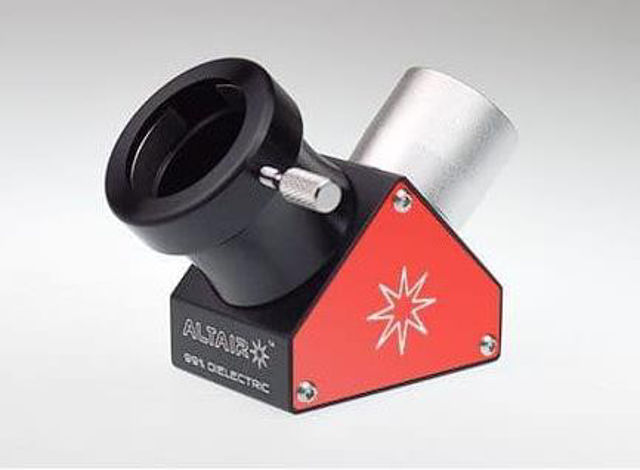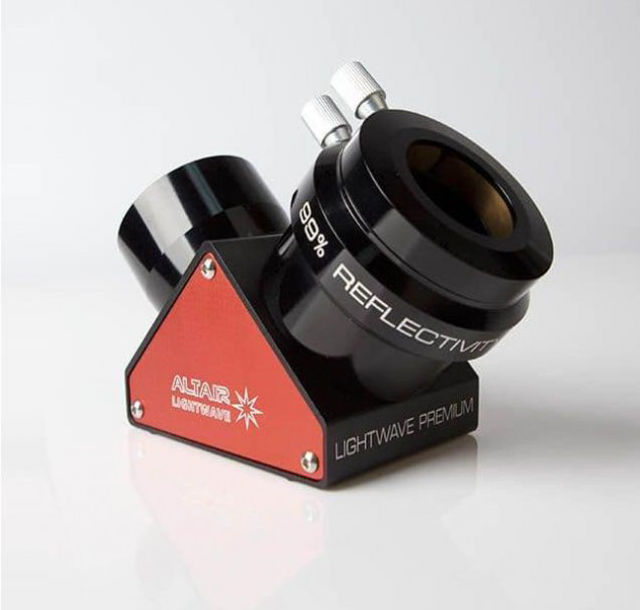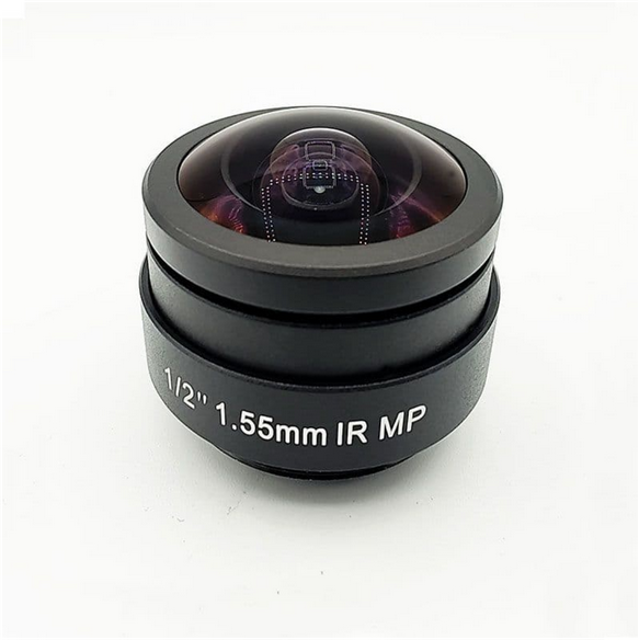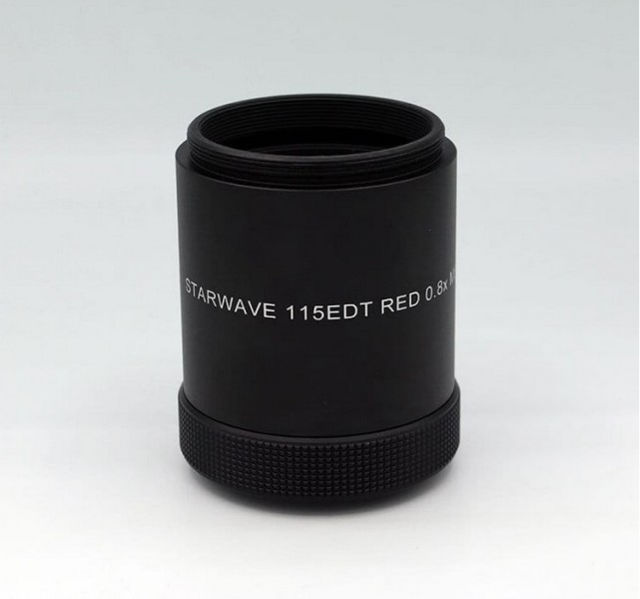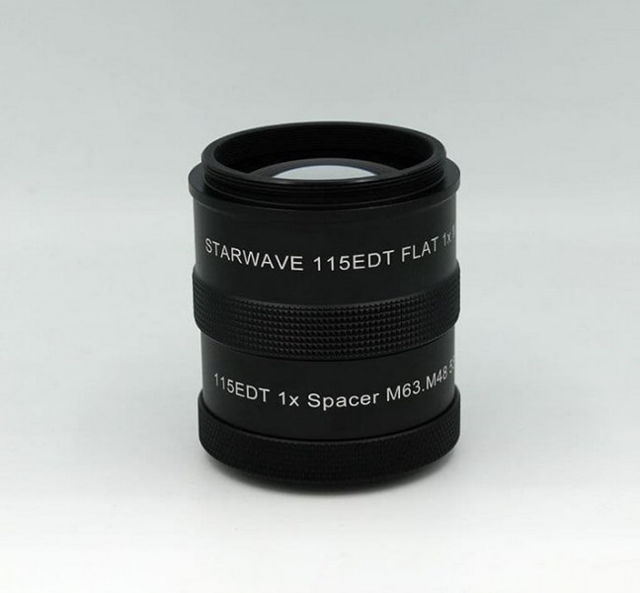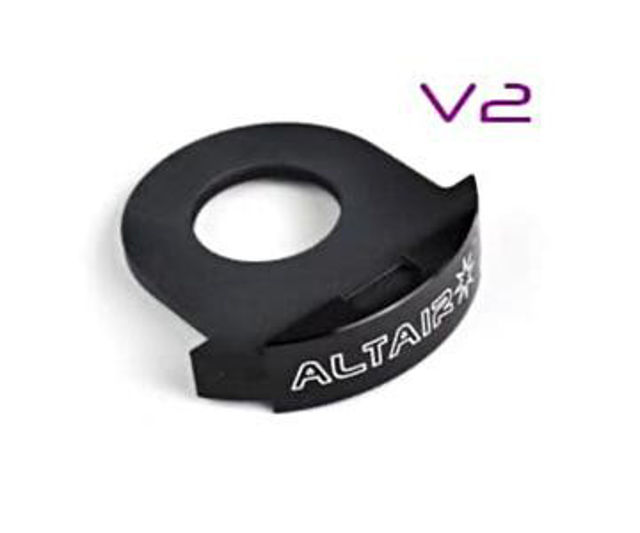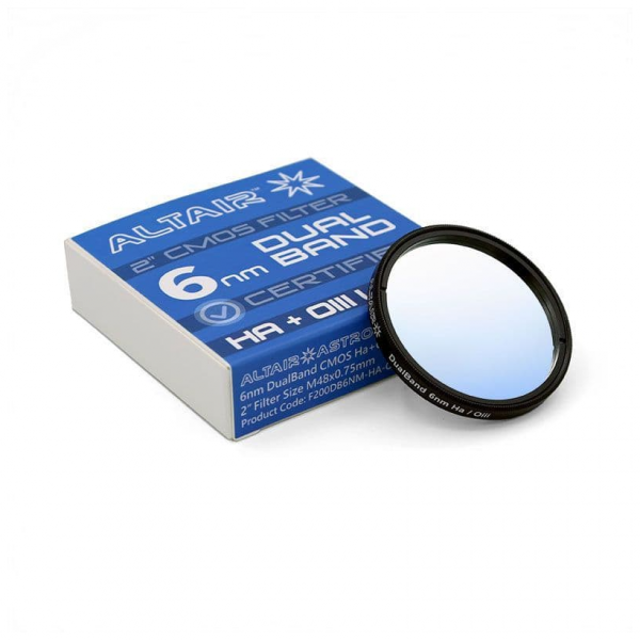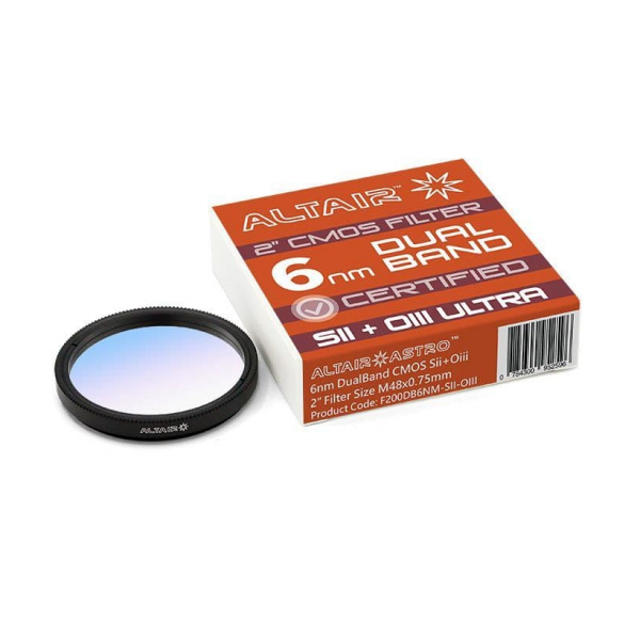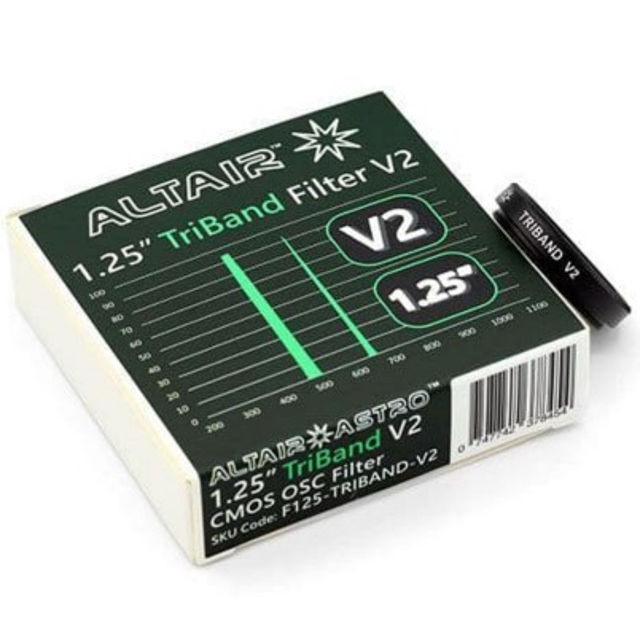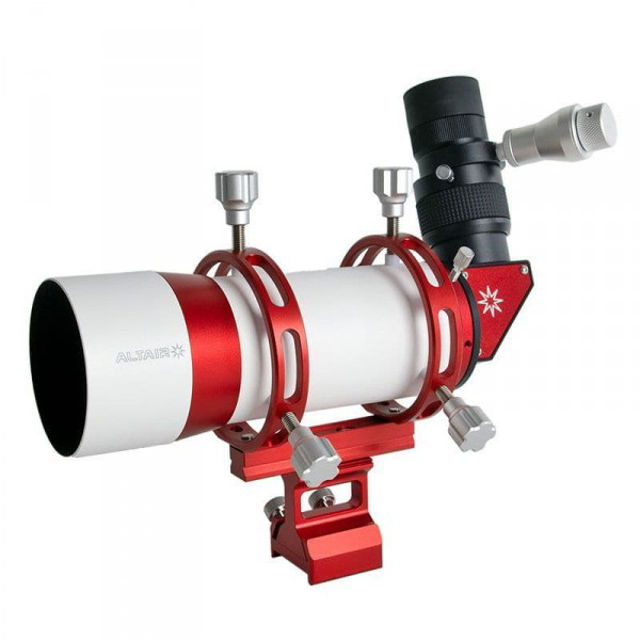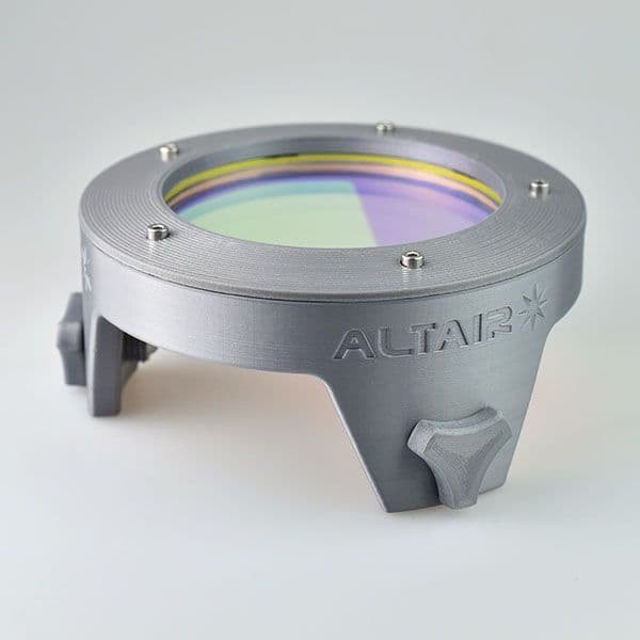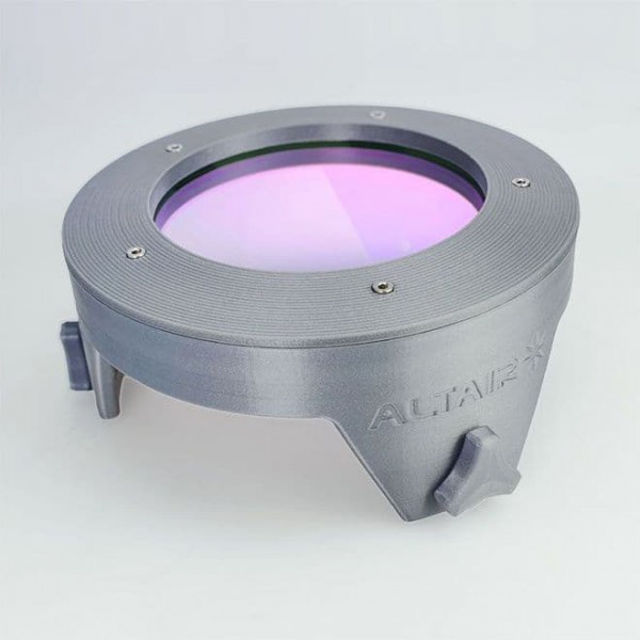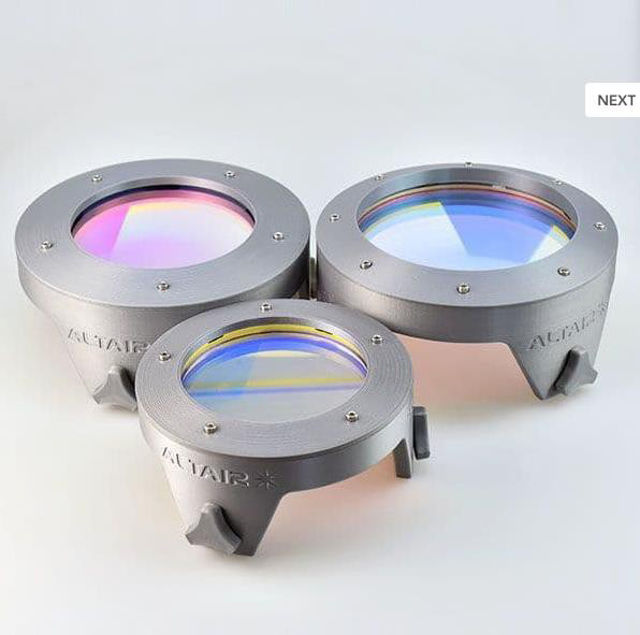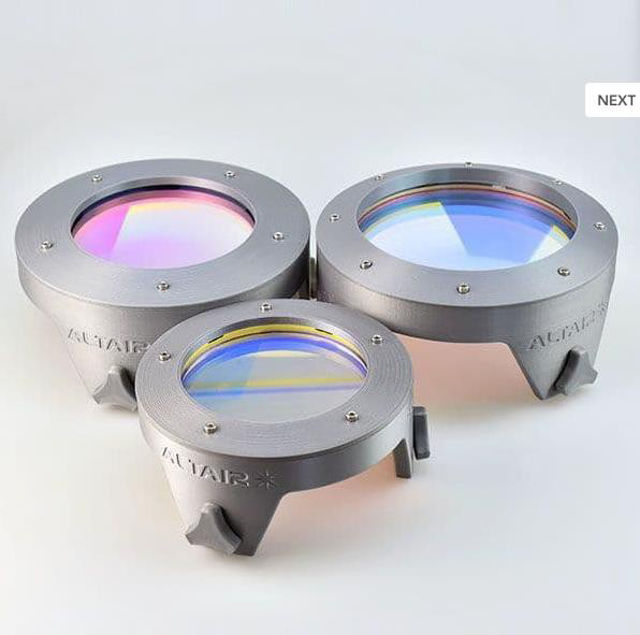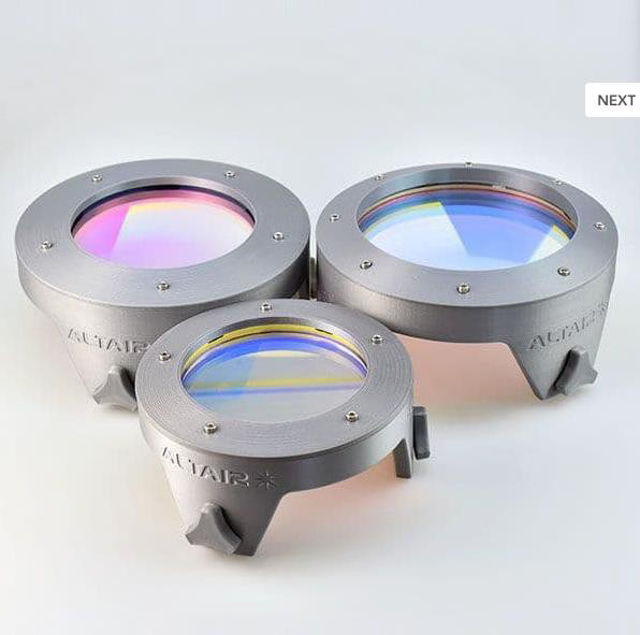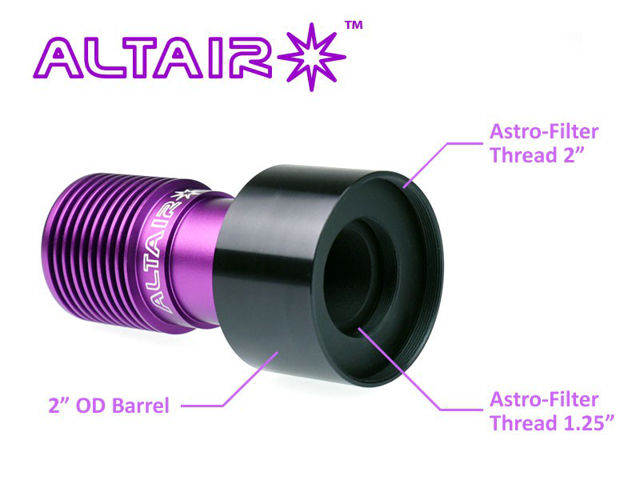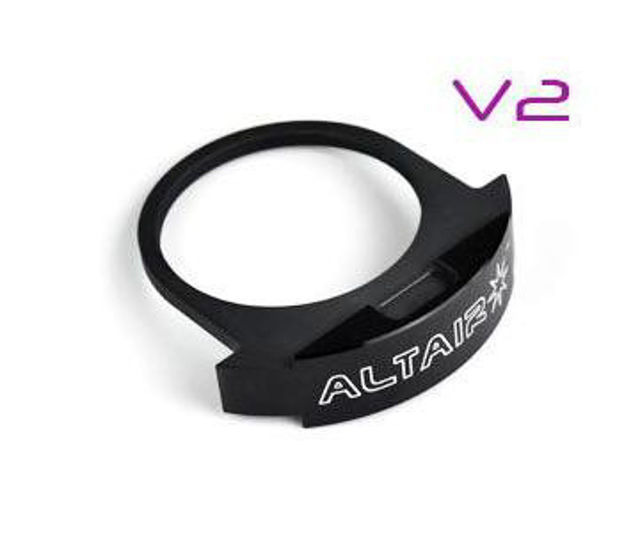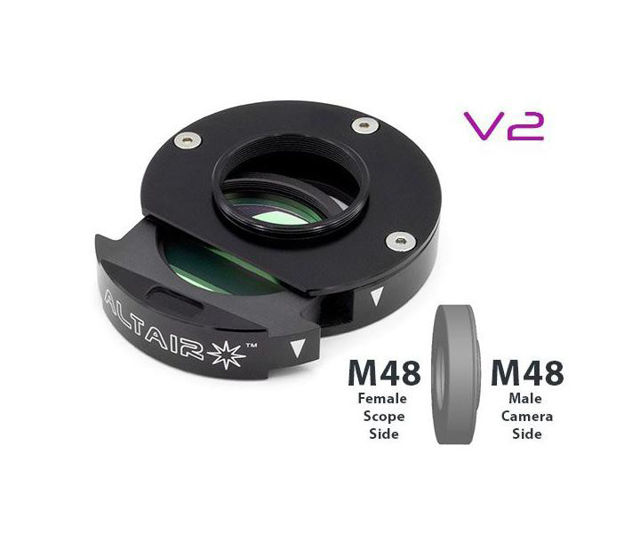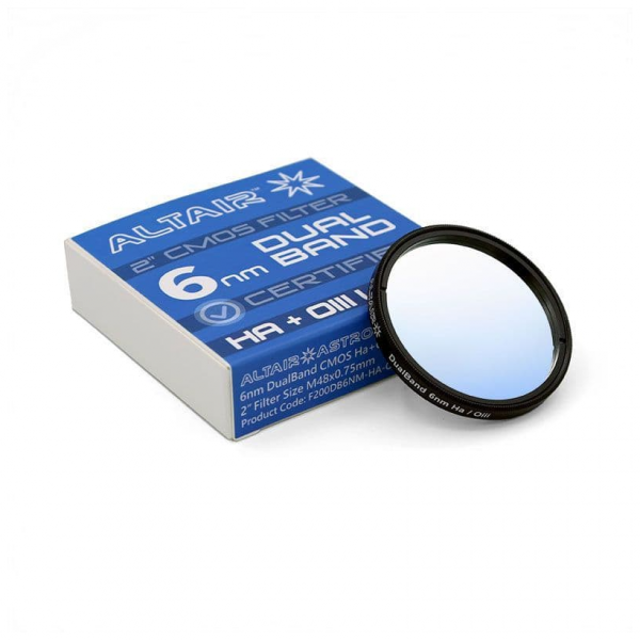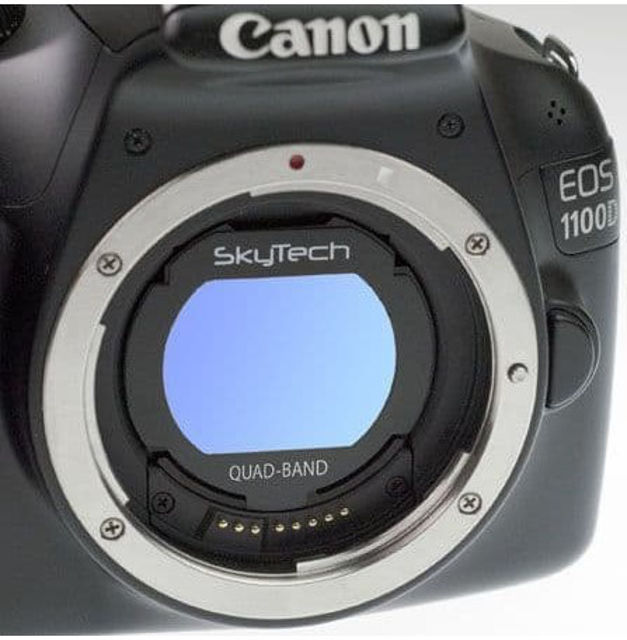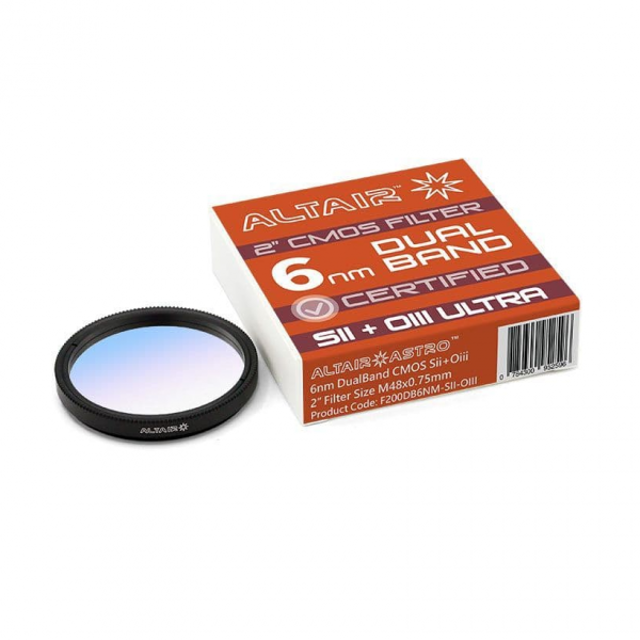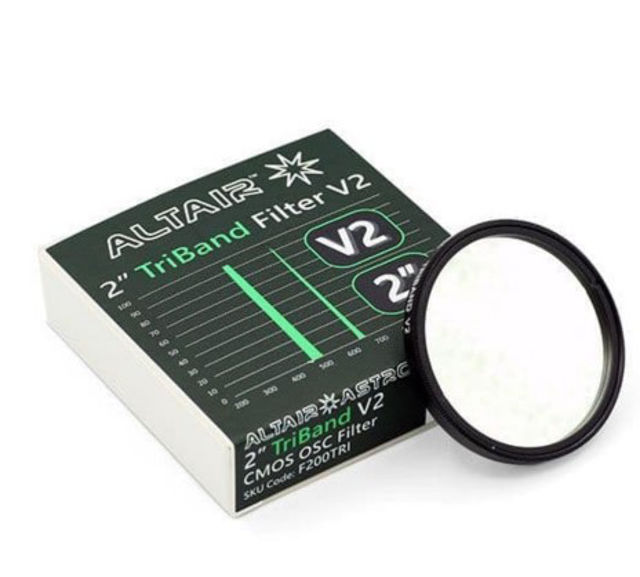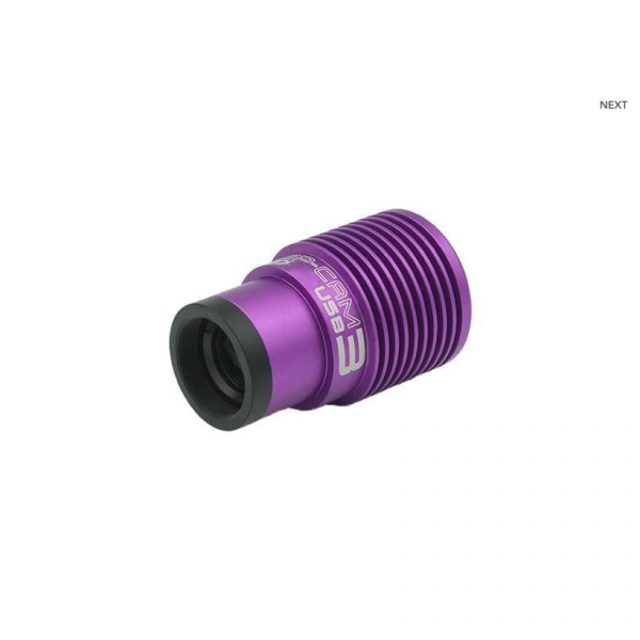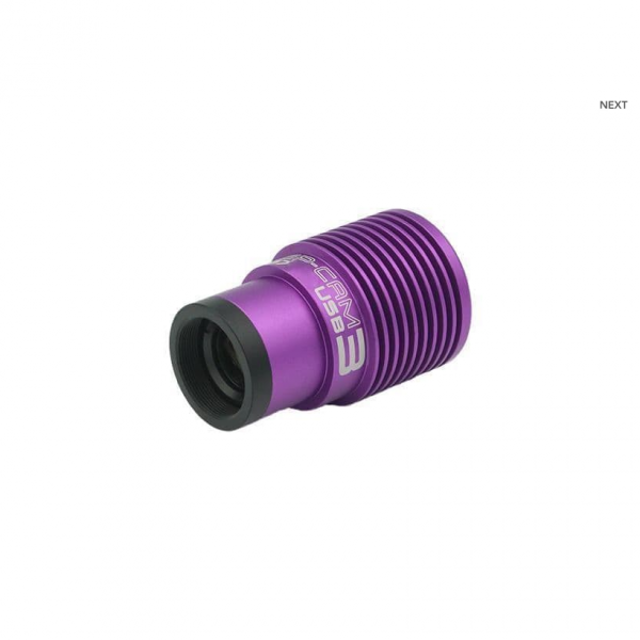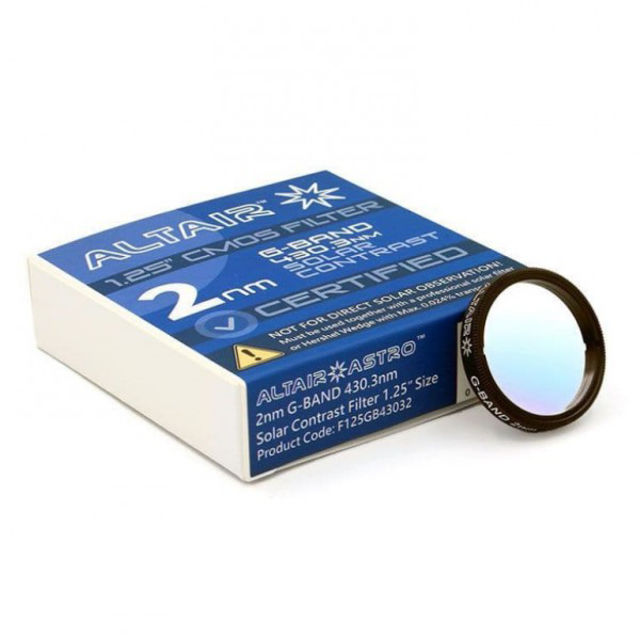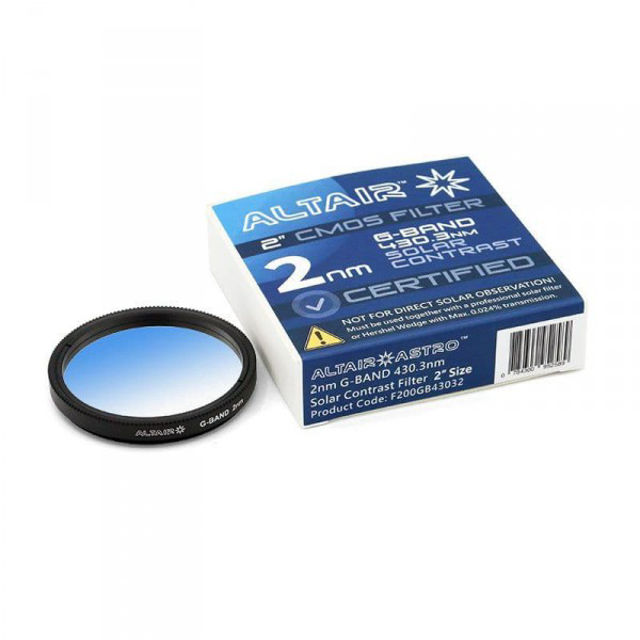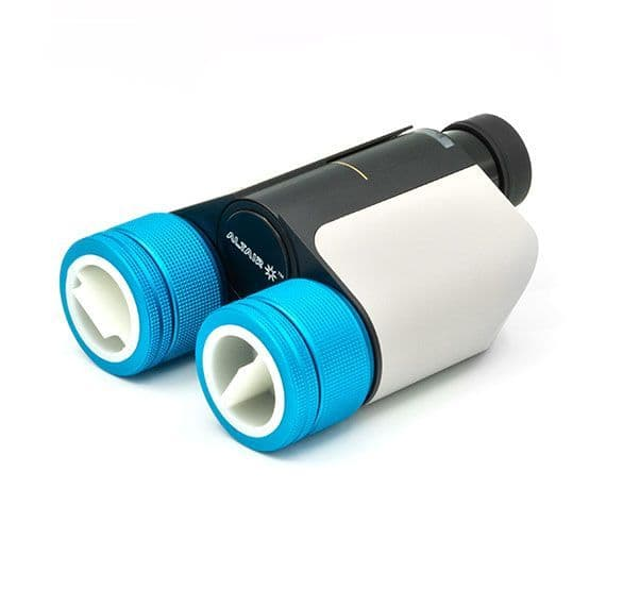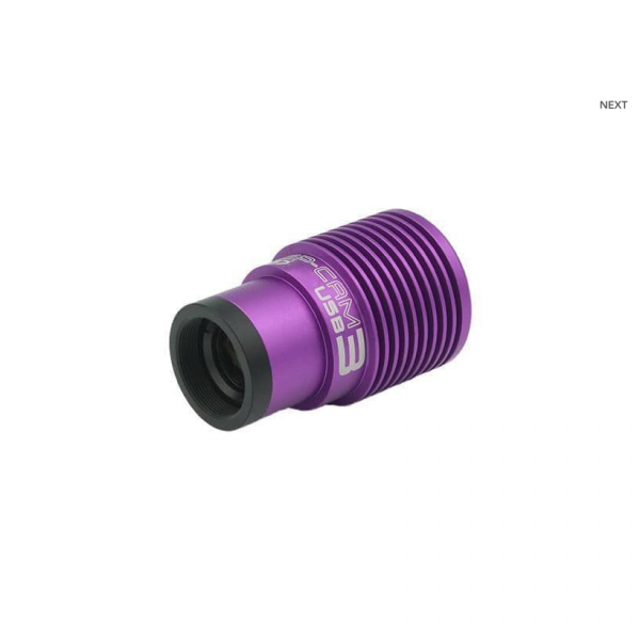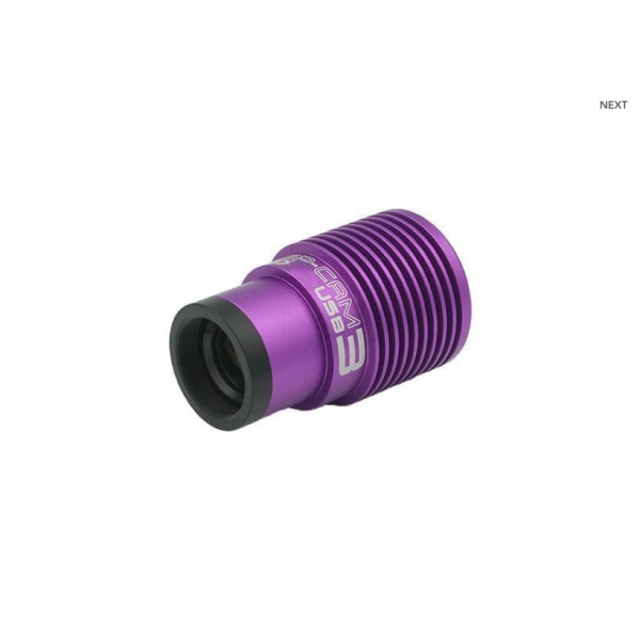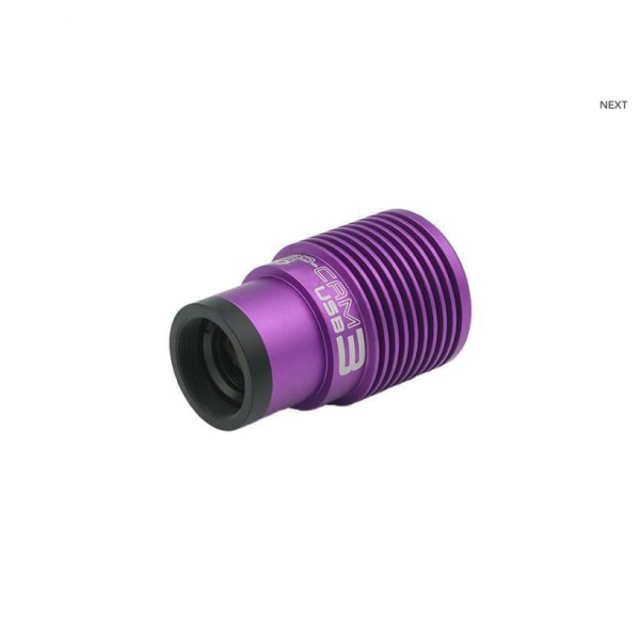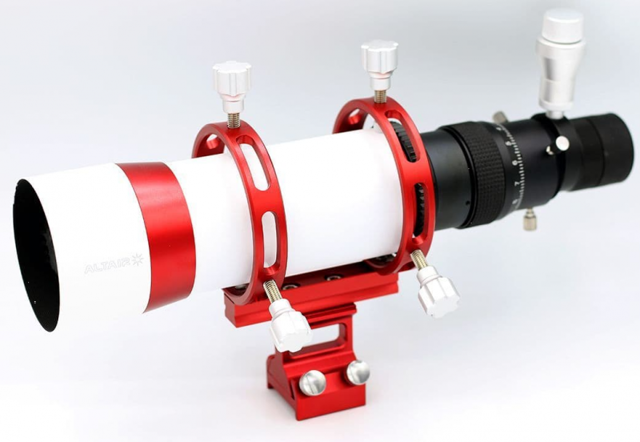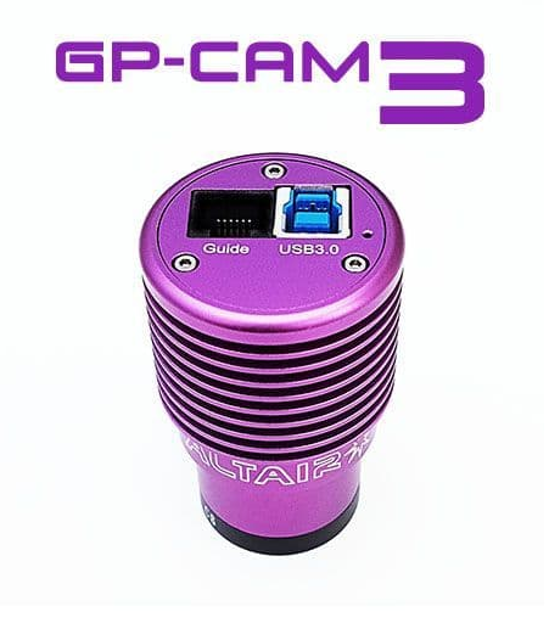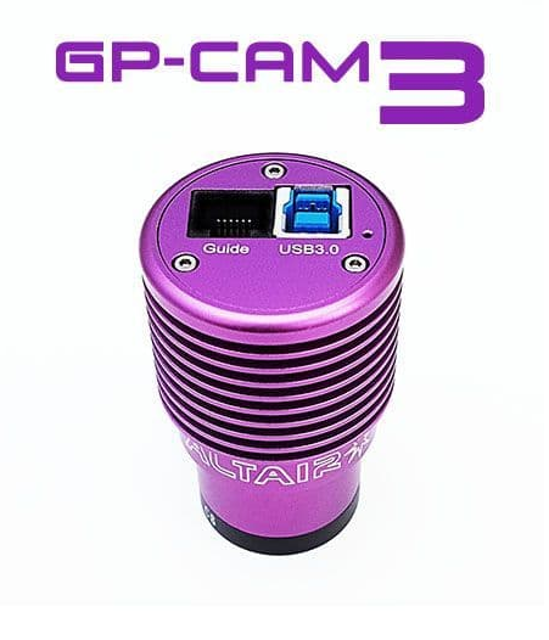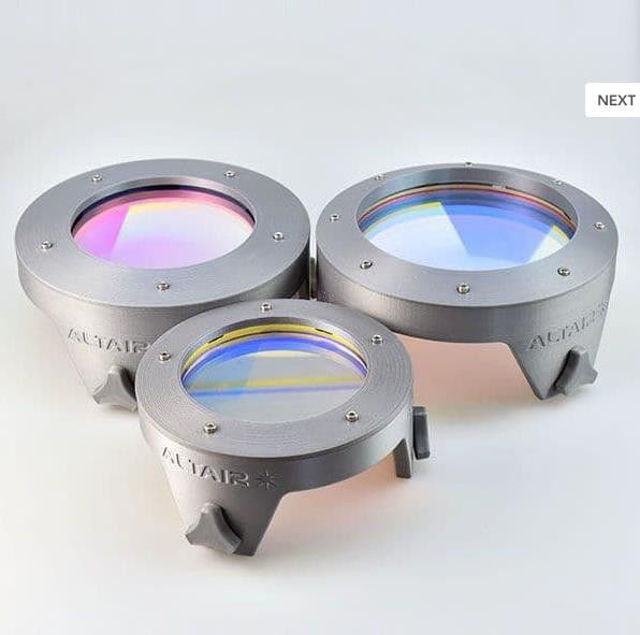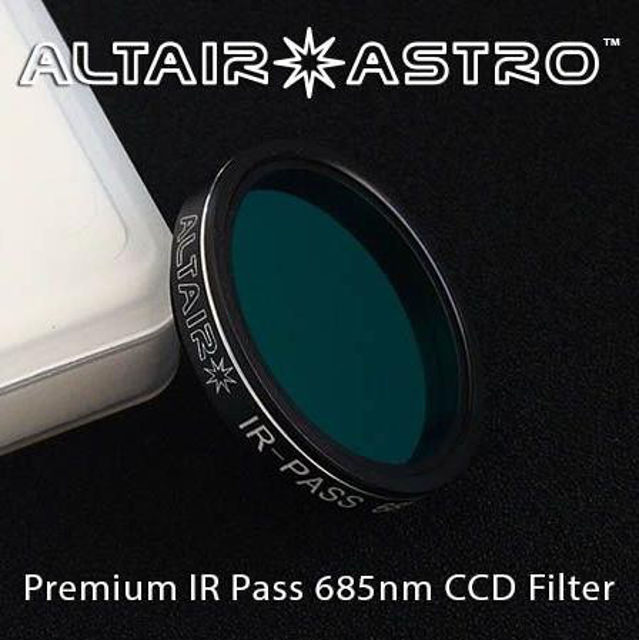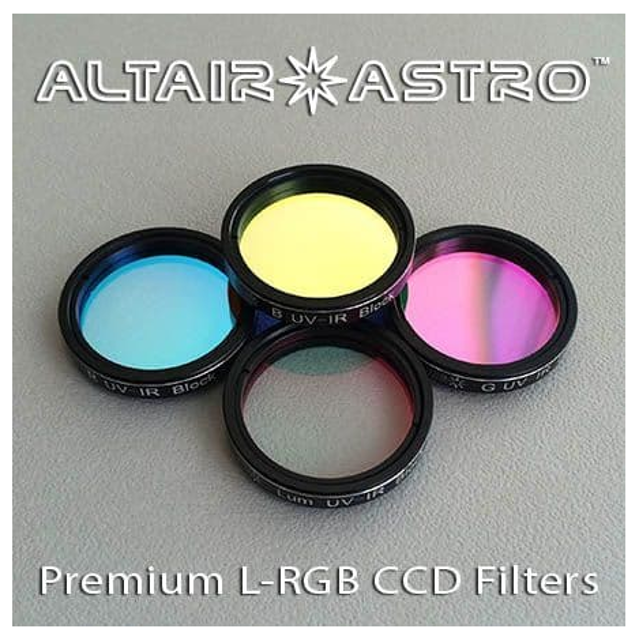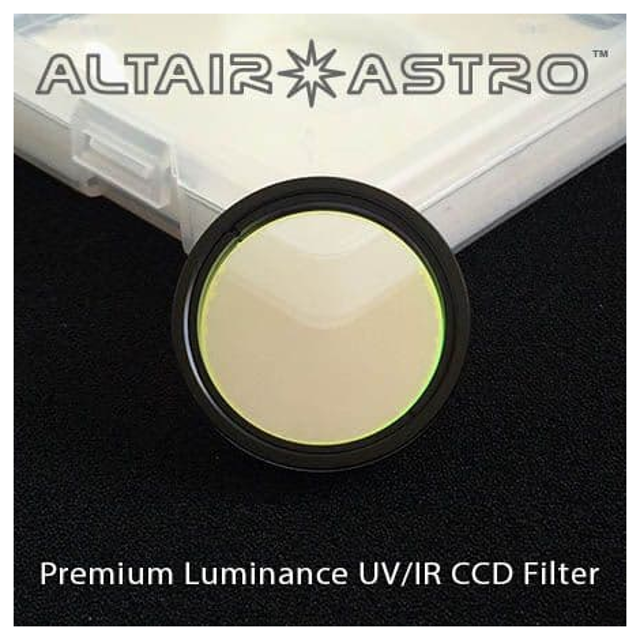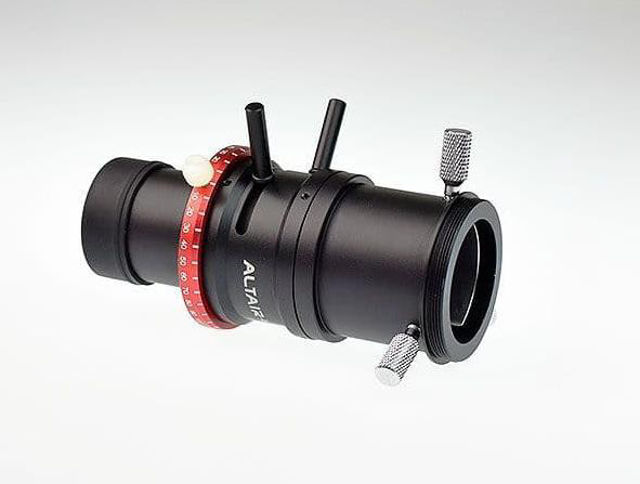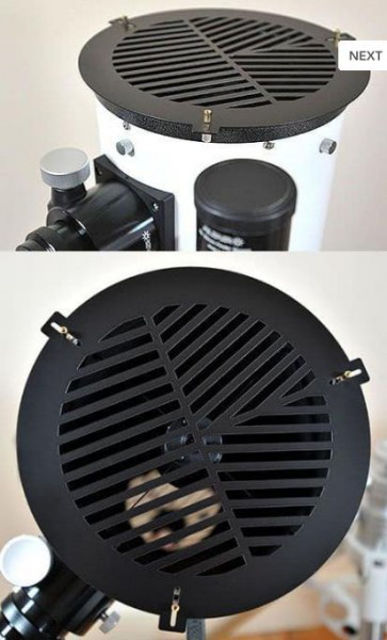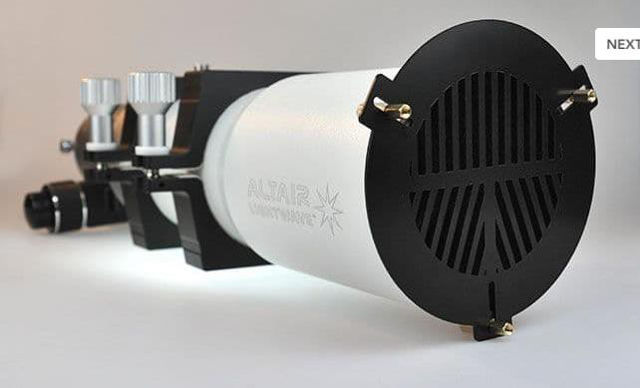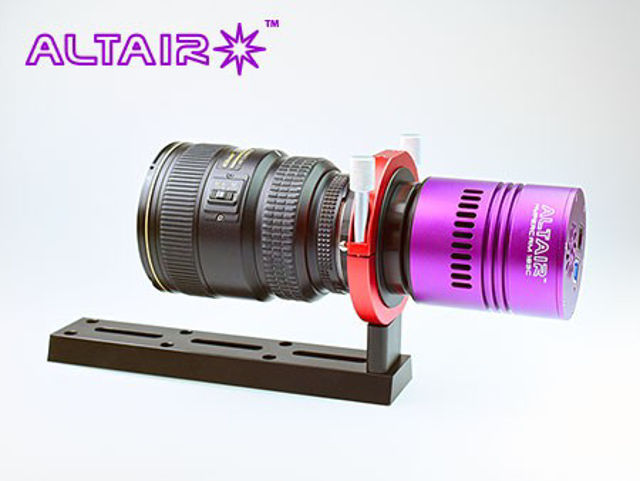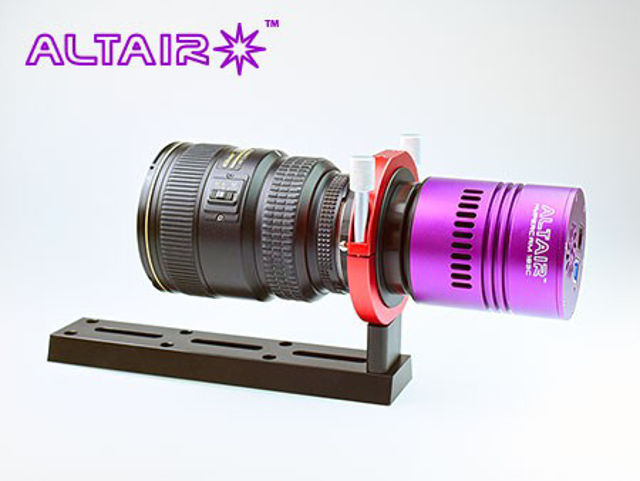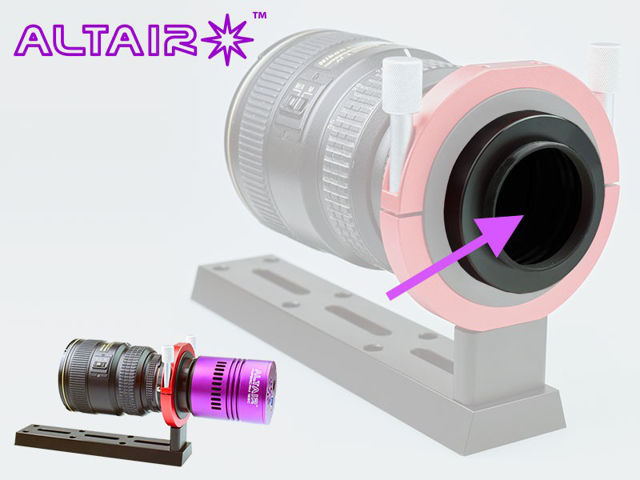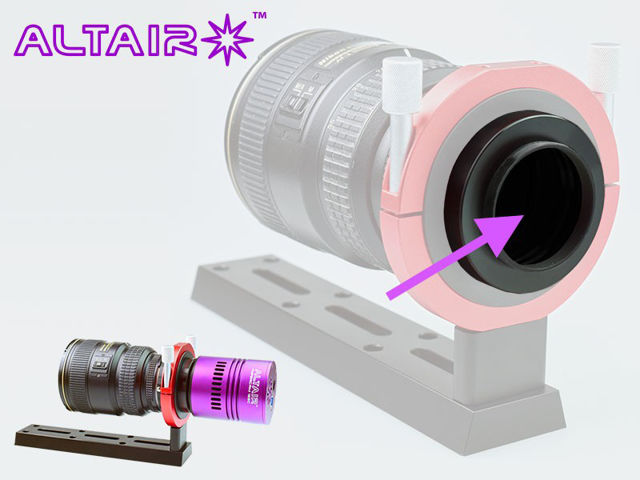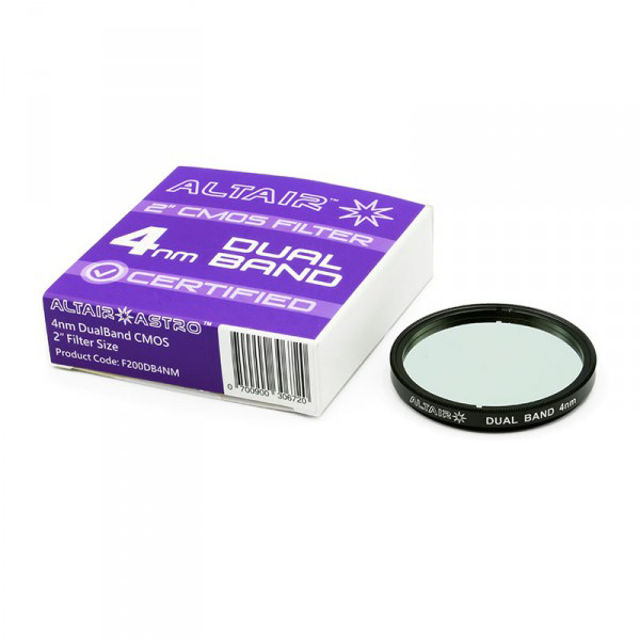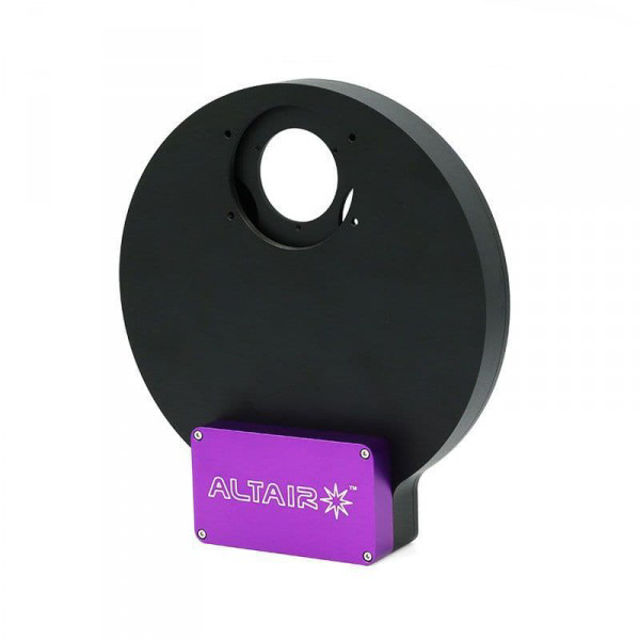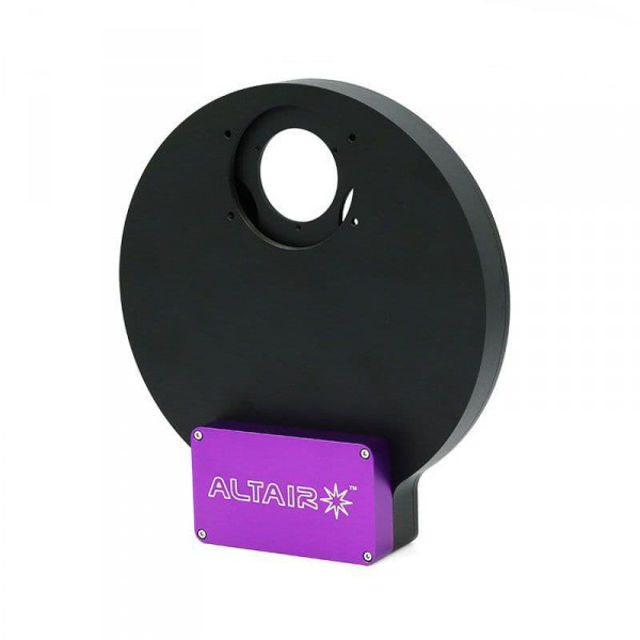Altair Astro

Altair Astro manufacturer of high quality astronomical accessories
Manufacturer in England of high quality accessories and distribution of CCD cameras. APM is a partially authorized dealer for Germany.
- Clear bright and sharp image from horizon to horizon for your Allsky Camera.
- Capture meteors, aurora, space stations and satellites over the entire sky.
- 1/2" camera chip will give you a full 180 degree plus image circle.
- 1/3" chip will have slightly clipped top and bottom edges.
- Fits Altair, ZWO, QHY and other Allsky CMOS cameras.
- Colour or mono NIR corrected.
It consists of two components:
- The flattener body containing the optics, with M92 male outer thread on the telescope side and M72 female inner thread on the camera side
- An M72 to M48 adaptor-spacer with M72 male outer thread on the flattener side and M48 male outer thread on the camera side. The adaptor has a 21.62mm optical length, to give 55mm sensor to flange distance.
Altair DualBand 6nm Filter Features:
- Capture the two main emission nebulae bands at the same time, whilst suppressing light pollution, moonlight, and airglow.
- Acquire more data in less time, opening up your imaging window, even into the summer months when it isn't quite dark.
- If you have the 6nm Ha/Sii Ultra filter and the Sii/Ha version, you can capture twice the Oiii data in each imaging session and combine them for true SHO Hubble style imaging with a colour camera!
- Extremely steep bandpass yields maximum contrast in extreme light pollution: 6nm FHWM centred on 500.7nm Oiii wavelength, and 5.5nm FHWM centred on the 656.28nm Ha wavelength.
- Halo suppression anti-reflective coating.
- Can be used with One Shot Colour (OSC) CMOS or mono astronomical cameras for luminance data.
- Includes UVIR blocking for both modified and un-modified DSLR cameras, plus an anti-reflection coating for the ultimate in contrast.
- Best performance at focal ratios at F4.8 or slower, however can be used as fast as F3.6, with minimal contrast impact (conservative estimate - faster may be possible). Like any dichroic filter, contrast increases as focal ratio number increases. More info about light pollution filter performance and focal ratio here.
Altair DualBand 6nm Filter Features:
- Capture the two main emission nebulae bands at the same time, whilst suppressing light pollution, moonlight, and airglow.
- Acquire more data in less time, opening up your imaging window, even into the summer months when it isn't quite dark.
- If you have the 6nm Sii Oiii Ultra filter and the Ha Oiii version, you can capture twice the Oiii data in each imaging session and combine them for true SHO Hubble style imaging with a colour camera!
- Extremely steep bandpass yields maximum contrast in extreme light pollution: 6nm FHWM centred on 500.7nm Oiii wavelength, and 5.5nm FHWM centred on the 671.6nm Sii wavelength.
- Halo suppression anti-reflective coating.
- Can be used with One Shot Colour (OSC) CMOS or mono astronomical cameras for luminance data.
- Includes UVIR blocking for both modified and un-modified DSLR cameras, plus an anti-reflection coating for the ultimate in contrast.
- Best performance at focal ratios at F4.8 or slower, however can be used as fast as F3.6, with minimal contrast impact (conservative estimate - faster may be possible). Like any dichroic filter, contrast increases as focal ratio number increases. More info about light pollution filter performance and focal ratio here.
The new TriBand V2 Filter
- Anti-Halo coating on both surfaces to reduce reflection artefacts from reducers and camera lenses.
- Increased blocking of UV, IR and unwanted visual range wavelengths. UV OD7 (T0.00001%) Visual OD5 (T0.001%) and IR OD4 (T0.01%) for the ultimate in skyglow blocking. This is an order of magnitude better than foreign filters.
- Higher transmission % of desired wavelengths Ttop 93% (Average 5% higher transmission of target wavelengths than V1). In general a 5% gain on foreign filters.
- Ha at 14nm and Oiii at 34nm FWHM for with less tail-off to reduce unwanted light pollution, whilst keeping transmission high compared to the V1.
- This finder is right angled for more comfort, with a corrected field (i.e. not mirror-reversed like other finders), so objects actually match their orientation in your star chart.
- The focuser can also be rotated 360° and locked in seconds (requiring some re-alignment afterwards). The 10mm larger objective and a little extra power compare to 8x50 finders, yet has almost the same size and weight.
- The included quick-release finder base has 4x 4mm slotted holes in the base allowing you to fit it to most telescopes on the market. (The mini-dovetail wedge on the bracket will fit any GSO or Skywatcher telescope directly in fact but we suggest you use the included base if it fits the tube, because it has 2x clamping screws, for better alignment).
- The CNC machined bracket is light yet rigid to keep alignment. Nylon tipped screws do not damage the durable high quality and moisture resistant powder coated aluminium tube.
- All objective lenses are anti-reflection coated and the tube and dewshield are internally blackened to increase contrast. The included illuminator has a variable setting, which illuminates the cross hairs in the eyepiece. The included eyepiece has a dark field illuminated cross-hair, so you can easily see it glowing faintly against the background sky, an upgrade for standard finders with dark cross-hairs.
- The high quality 1.25 FMC illuminated eyepiece has good eye relief for glasses-wearers, and a wide field of view. It has a side-port to screw in the included variable darkfield illuminated reticule, and the finder can be very easily focused, using the included helical focuser integrated with the prism diagonal.
Product Features:
- Reduces approx. 98% of heat reaching the optics to keep Etalon from drifting off-band and protect your equipment.
- 30nm FHWM Bandpass at H-alpha (H) wavelength of 656.28 nm (Full Width Half Minimum) Transmission: ~95.5%
- 40nm FHWM Bandpass with CWL at 395nm covering Calcium H-Line and Calcium K-Line wavelengths. Transmission: ~90.5%
- UVIR blocking OD3 0.1% @400-1100nm blocking over 98% of heat to your 3rd party Etalon at eyepiece or camera end, E.g. Daystar Quark). Please note it's your responsibility to use a proper commercial Etalon with this product, and to follow the manufacturer's instructions.
- Visible light blocking: OD4 0.01% @400-700nm to reduce reflection effects and over 98% of heat.
- Diameter 120mm Thickness 12.0mm (required to achieve surface precision)
- Multilayer coatings with SiO2 protective overcoat.
- ERF Holder cell included with soft tip threaded knobs. Tough and very light, easy to disassemble for cleaning the filter with optical wipes. Cell does not put any tension on the optics.
Altair 130mm Aperture Energy Rejection filter - Ha Hydrogen Alpha only D-ERF for 5" Refractors
Product Features:
- Reduces approx. 98% of heat reaching the optics to keep Etalon from drifting off-band and protect your equipment.
- 30-40nm FHWM Bandpass at H-alpha (H) wavelength of 656.28 nm (Full Width Half Minimum) Transmission: ~90%
- UVIR blocking OD3 0.1% @400-1100nm blocking over 98% of heat to your 3rd party Etalon at eyepiece or camera end, E.g. Daystar Quark). Please note it's your responsibility to use a proper commercial Etalon with this product, and to follow the manufacturer's instructions.
- Visible light blocking: OD4 0.01% @400-700nm to reduce reflection effects and over 98% of heat.
- Diameter 140mm Thickness 12.0mm
- Multilayer coatings with SiO2 protective overcoat.
- ERF Holder cell included with soft tip threaded knobs. Tough and very light, easy to disassemble for cleaning the filter with optical wipes. Cell does not put any tension on the optics and will not scratch or damage your telescope. It also won't alter the balance as much as an aluminium cell.
- Reduces approx. 98% of heat reaching the optics to keep Etalon from drifting off-band and protect your equipment.
- 30nm FHWM Bandpass at H-alpha (H) wavelength of 656.28 nm (Full Width Half Minimum) Transmission: ~95.5%
- 40nm FHWM Bandpass with CWL at 395nm covering Calcium H-Line and Calcium K-Line wavelengths. Transmission: ~90.5%
- UVIR blocking OD3 0.1% @400-1100nm blocking over 98% of heat to your 3rd party Etalon at eyepiece or camera end, E.g. Daystar Quark). Please note it's your responsibility to use a proper commercial Etalon with this product, and to follow the manufacturer's instructions.
- Visible light blocking: OD4 0.01% @400-700nm to reduce reflection effects and over 98% of heat.
- Diameter 140mm Thickness 12.0mm (required to achieve surface precision)
- Multilayer coatings with SiO2 protective overcoat.
- ERF Holder cell included with soft tip threaded knobs. Tough and very light, easy to disassemble for cleaning the filter with optical wipes. Cell does not put any tension on the optics.
Altair DualBand 6nm Filter Features:
- Capture the two main emission nebulae bands at the same time, whilst suppressing light pollution, moonlight, and airglow.
- Acquire more data in less time, opening up your imaging window, even into the summer months when it isn't quite dark.
- If you have the 6nm Ha/Sii Ultra filter and the Sii/Ha version, you can capture twice the Oiii data in each imaging session and combine them for true SHO Hubble style imaging with a colour camera!
- Extremely steep bandpass yields maximum contrast in extreme light pollution: 6nm FHWM centred on 500.7nm Oiii wavelength, and 5.5nm FHWM centred on the 656.28nm Ha wavelength.
- Halo suppression anti-reflective coating.
- Can be used with One Shot Colour (OSC) CMOS or mono astronomical cameras for luminance data.
- Includes UVIR blocking for both modified and un-modified DSLR cameras, plus an anti-reflection coating for the ultimate in contrast.
- Best performance at focal ratios at F4.8 or slower, however can be used as fast as F3.6, with minimal contrast impact (conservative estimate - faster may be possible). Like any dichroic filter, contrast increases as focal ratio number increases. More info about light pollution filter performance and focal ratio here.
High quality filter for CMOS photography with the following features:
- 1st band, CWL495nm FWHM35nm
- 2nd band, CWL 660nm FWHM 35nm
- 1mm thick optical glass with 30 arc sec parallelism.
- UVIR Block and Anti-Reflection Coating.
Altair DualBand 6nm Filter Features:
- Capture the two main emission nebulae bands at the same time, whilst suppressing light pollution, moonlight, and airglow.
- Acquire more data in less time, opening up your imaging window, even into the summer months when it isn't quite dark.
- If you have the 6nm Sii Oiii Ultra filter and the Ha Oiii version, you can capture twice the Oiii data in each imaging session and combine them for true SHO Hubble style imaging with a colour camera!
- Extremely steep bandpass yields maximum contrast in extreme light pollution: 6nm FHWM centred on 500.7nm Oiii wavelength, and 5.5nm FHWM centred on the 671.6nm Sii wavelength.
- Halo suppression anti-reflective coating.
- Can be used with One Shot Colour (OSC) CMOS or mono astronomical cameras for luminance data.
- Includes UVIR blocking for both modified and un-modified DSLR cameras, plus an anti-reflection coating for the ultimate in contrast.
- Best performance at focal ratios at F4.8 or slower, however can be used as fast as F3.6, with minimal contrast impact (conservative estimate - faster may be possible). Like any dichroic filter, contrast increases as focal ratio number increases. More info about light pollution filter performance and focal ratio here.
The new TriBand V2 Filter
- Anti-Halo coating on both surfaces to reduce reflection artefacts from reducers and camera lenses.
- Increased blocking of UV, IR and unwanted visual range wavelengths. UV OD7 (T0.00001%) Visual OD5 (T0.001%) and IR OD4 (T0.01%) for the ultimate in skyglow blocking. This is an order of magnitude better than foreign filters.
- Higher transmission % of desired wavelengths Ttop 93% (Average 5% higher transmission of target wavelengths than V1). In general a 5% gain on foreign filters.
- Ha at 14nm and Oiii at 34nm FWHM for with less tail-off to reduce unwanted light pollution, whilst keeping transmission high compared to the V1.
- SC 2210 Colour CMOS Sensor
- 1920 x 1080 pixel resolution:
- 4 um Square Pixels
- 1/1.8-inch Optical Format
- 12-bit ADC
- 512mb DDR3 Memory
- G Sensitivity: 20100mv/lux*s
- Low Noise: : 0.47 to 3.2e-
- Fast Frame Rate 50 FPS in 8bit mode
- Binning from 1x1 to 8x8 in either stacking or averaging modes.
- SC 2210 Mono CMOS Sensor
- 1920 x 1080 pixel resolution:
- 4 um Square Pixels
- 1/1.8-inch Optical Format
- 12-bit ADC
- 512mb DDR3 Memory
- G Sensitivity: 20100mv/lux*s
- Low Noise: : 0.47 to 3.2e-
- Fast Frame Rate 50 FPS in 8bit mode
- Binning from 1x1 to 8x8 in either stacking or averaging modes.
Altair 2nm G-Band Solar Contrast Filter filter specifications:
- Standard 1.25" Filter Threaded Aluminium Cell
- CWL 430.3nm @ 96% transmission, tolerance 1%
- FWHM 2nm, tolerance 0.5nm.
- 1.85mm thick quartz ?/4, Parallelism (arcsec) 30"
- Si02 "hard" overcoat with UVIR Block 300-1100nm and Anti-Reflection Coating
- High resolution spectrographic test report included corresponding to each individual filter.
Altair 2nm G-Band Solar Contrast Filter filter specifications:
- Standard 2" Filter Threaded Aluminium Cell
- CWL 430.3nm @ 96% transmission, tolerance 1%
- FWHM 2nm, tolerance 0.5nm.
- 1.85mm thick quartz ?/4, Parallelism (arcsec) 30"
- Si02 "hard" overcoat with UVIR Block 300-1100nm and Anti-Reflection Coating
- High resolution spectrographic test report included corresponding to each individual filter.
The Altair wide-field binoviewer allows vignetting-free observations with almost all 1.25" eyepieces through oversized prisms.
- Clear aperture 28 mm / prism diameter 30 mm
- 1.25 connection on the telescope
- Prism surface Lambda/8
- Self-centering eyepiece connection for perfect fit of the eyepieces, also with safety groove
- Built-in micro focuser for diopter compensation on each side
- Short design with only 118.5 mm optical path - can be used with many refractors without compensating the optical path
- Robust transport and storage case included in the scope of delivery
Feature summary GPCAM3 462C:
- 1920 x 1080 Resolution
- 2.9 um Square Pixels
- 1/2.8-inch sensor format
- 5.57mm x 3.13mm sensor size
- Low Read Noise: 0.49 to 2.1e-
- High Frame Rate 152 FPS 8 bit
- 12-bit ADC
- Binning from 1x1 to 8x8 in either stacking or averaging modes.
Feature summary GPCAM3 462C:
- 1920 x 1080 Resolution
- 2.9 um Square Pixels
- 1/2.8-inch sensor format
- 5.57mm x 3.13mm sensor size
- Low Read Noise: 0.49 to 2.1e-
- High Frame Rate 152 FPS 8 bit
- 12-bit ADC
- Binning from 1x1 to 8x8 in either stacking or averaging modes.
Feature summary GPCAM3 462M:
- 1920 x 1080 Resolution
- 2.9 um Square Pixels
- 1/2.8-inch sensor format
- 5.57mm x 3.13mm sensor size
- Low Read Noise: 0.49 to 2.1e-
- High Frame Rate 152 FPS 8 bit
- 12-bit ADC
- Binning from 1x1 to 8x8 in either stacking or averaging modes.
Fast 60mm viewfinder with helical focuser and tube clamps
Key data
- 60mm aperture
- 225mm focal length at a focal ratio of f/3.75
- Illuminated crosshair eyepiece
- Helical focuser (the image does not rotate when focusing)
- Complete tube clamp set with mounting material
- Can also be used as a guidescope
Feature summary Altair 678C CMOS Camera:
- IMX678 Colour Starvis 2 CMOS Sensor
- On-chip HGC and LCG Support
- 3840 x 2160 pixel resolution:
- 2 um Square Pixels
- 1/1.8-inch Optical Format
- 12-bit ADC
- 512mb DDR3 Memory
- G Sensitivity: 3637mv
- Low Noise: 0.42 to 2.43e-
- Fast Frame Rate 47 FPS in 8bit mode
- Binning from 1x1 to 8x8 in either stacking or averaging modes.
Feature summary Altair 678C CMOS Camera:
- IMX678 Colour Starvis 2 CMOS Sensor
- On-chip HGC and LCG Support
- 3840 x 2160 pixel resolution:
- 2 um Square Pixels
- 1/1.8-inch Optical Format
- 12-bit ADC
- 512mb DDR3 Memory
- G Sensitivity: 3637mv
- Low Noise: 0.42 to 2.43e-
- Fast Frame Rate 47 FPS in 8bit mode
- Binning from 1x1 to 8x8 in either stacking or averaging modes.
- Batch-tested for consistency.
- High quality dichroic/dielectric coatings.
- Anti-Reflection coating to reduce star-halos - stackable.
- UV/IR block for imaging - star bloat reduction with refractors.
- Ultra-flat glass by Schott Germany.
- Precision CNC machined filter cell for strain-free mounting and freedom from tilt.
- Batch-tested for consistency.
- High quality dichroic/dielectric coatings.
- Anti-Reflection coating to reduce star-halos - stackable.
- UV/IR block for imaging - star bloat reduction with refractors.
- Ultra-flat glass by Schott Germany.
- Precision CNC machined filter cell for strain-free mounting and freedom from tilt.
With the TS ADC your images of moon and planets as well as your observations near the horizon become significantly sharper and more detailed.
- Corrects the color shift (Dispersion) of our atmosphere - less color fringing, more sharpness and detail
- Convenient operation with eyepiece attached - simply rotate the lever and notice how the sharpness of your view or camera image improves.
- The principle behind the ADC is simple - two prisms are shifted relatively to each other and thereby compensate the color shift of the atmosphere (see image)
- A ring scale allows for reproducable adjustments
- Simple adaptation on the telescope side and eyepiece side via 1.25" receptacle and T2 thread
- Ultraslim design - the TS ADC can even be attached to binoviewers - height without T2 connection parts only 29 mm from T2 to T2
- Usable among others for observation and photography of planets, the moon or double stars
The Altair Electronic Filter Wheel EFW holds 5x2" astronomy filters and is driven by a precision stepper motor with accurate positioning system.
The Altair Electronic Filter Wheel EFW holds 7x2" astronomy filters and is driven by a precision stepper motor with accurate positioning system.
